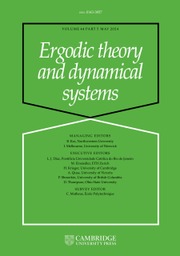No CrossRef data available.
Article contents
On Dirichlet non-improvable numbers and shrinking target problems
Published online by Cambridge University Press: 11 June 2025
Abstract
In one-dimensional Diophantine approximation, the Diophantine properties of a real number are characterized by its partial quotients, especially the growth of its large partial quotients. Notably, Kleinbock and Wadleigh [Proc. Amer. Math. Soc. 146(5) (2018), 1833–1844] made a seminal contribution by linking the improvability of Dirichlet’s theorem to the growth of the product of consecutive partial quotients. In this paper, we extend the concept of Dirichlet non-improvable sets within the framework of shrinking target problems. Specifically, consider the dynamical system  $([0,1), T)$ of continued fractions. Let
$([0,1), T)$ of continued fractions. Let  $\{z_n\}_{n \ge 1}$ be a sequence of real numbers in
$\{z_n\}_{n \ge 1}$ be a sequence of real numbers in  $[0,1]$ and let
$[0,1]$ and let  $B> 1$. We determine the Hausdorff dimension of the following set:
$B> 1$. We determine the Hausdorff dimension of the following set:  $ \{x\in [0,1):|T^nx-z_n||T^{n+1}x-Tz_n|<B^{-n}\text { infinitely often}\}. $
$ \{x\in [0,1):|T^nx-z_n||T^{n+1}x-Tz_n|<B^{-n}\text { infinitely often}\}. $
Information
- Type
- Original Article
- Information
- Copyright
- © The Author(s), 2025. Published by Cambridge University Press


